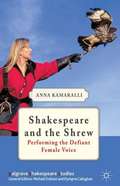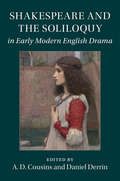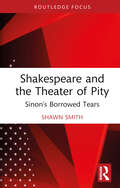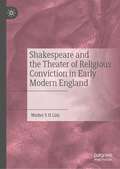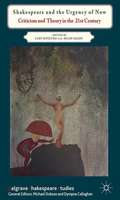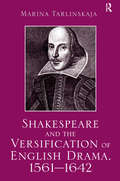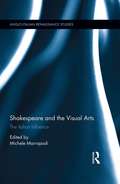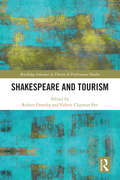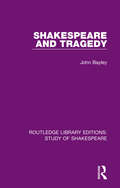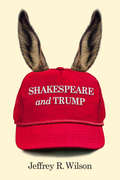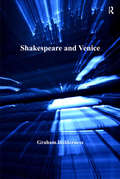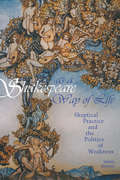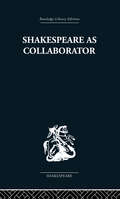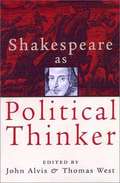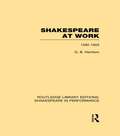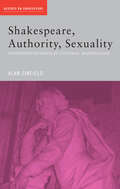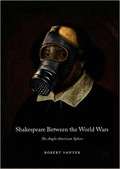- Table View
- List View
Shakespeare and the Second World War
by Marissa Mchugh Irena MakarykShakespeare's works occupy a prismatic and complex position in world culture: they straddle both the high and the low, the national and the foreign, literature and theatre. The Second World War presents a fascinating case study of this phenomenon: most, if not all, of its combatants have laid claim to Shakespeare and have called upon his work to convey their society's self-image.In wartime, such claims frequently brought to the fore a crisis of cultural identity and of competing ownership of this 'universal' author. Despite this, the role of Shakespeare during the Second World War has not yet been examined or documented in any depth. Shakespeare and the Second World War provides the first sustained international, collaborative incursion into this terrain. The essays demonstrate how the wide variety of ways in which Shakespeare has been recycled, reviewed, and reinterpreted from 1939-1945 are both illuminated by and continue to illuminate the War today.
Shakespeare and the Shrew
by Anna KamaralliWhenever Shakespeare wrote a 'shrew' into one of his plays he created a character who challenged ideas about acceptable behaviour for a woman. This is as true today as when the plays were first performed. A shrew is a woman who refuses to be quiet when she is told to be, who says things that people do not want to hear. She is constructed to alleviate male anxieties through ridicule, but like so many objects of comedy or derision, she is full of power because of her very ability to generate these anxieties. 'Shrew' is supposed to be an insult, but has often been used to describe women enacting behaviour that can be brave, clever, noble or just. This book marries an examination of Shakespeare's shrews in his plays with their history in recent performance, to investigate our own attitudes to hearing women with defiant voices.
Shakespeare and the Soliloquy in Early Modern English Drama
by A. D. Cousins Daniel DerrinEncompassing nearly a century of drama, this is the first book to provide students and scholars with a truly comprehensive guide to the early modern soliloquy. Considering the antecedents of the form in Roman, late fifteenth and mid-sixteenth century drama, it analyses its diversity, its theatrical functions and its socio-political significances. Containing detailed case-studies of the plays of Marlowe, Shakespeare, Jonson, Ford, Middleton and Davenant, this collection will equip students in their own close-readings of texts, providing them with an indepth knowledge of the verbal and dramaturgical aspects of the form. Informed by rich theatrical and historical understanding, the essays reveal the larger connections between Shakespeare's use of the soliloquy and its deployment by his fellow dramatists.
Shakespeare and the Theater of Pity: Sinon’s Borrowed Tears (Routledge Focus on Literature)
by Shawn SmithThis volume explores Shakespeare’s interest in pity, an emotion that serves as an important catalyst for action within the plays, even as it generates one of the audience’s most common responses to tragic drama in the theater. For Shakespeare, the word "pity" contained a broader range of meaning than it does in modern English, and was often associated with ideas such as mercy, compassion, charity, pardon, and clemency. This cluster of ideas provides Shakespeare’s characters with a rich range of possibilities for engaging some of humanity’s deepest emotional commitments, in which pity can be seen as a powerful stimulus for fostering social harmony, love, and forgiveness. However, Shakespeare also dramatizes pity’s potential for deception, when the appeal to pity is not genuine, and conceals contrary motives of vengeance and cruelty. As Shakespeare’s works remain relevant for modern audiences and readers, so too does his dramatization of the powerful ways in which emotions such as pity remain essential to our understanding of our shared humanity and of our awareness of compassion’s role in our own private and civic lives.
Shakespeare and the Theater of Religious Conviction in Early Modern England
by Walter S LimThis book analyzes Shakespeare’s use of biblical allusions and evocation of doctrinal topics in Hamlet, Measure for Measure, The Winter’s Tale, Richard II, and The Merchant of Venice. It identifies references to theological and doctrinal commonplaces such as sin, grace, confession, damnation, and the Fall in these plays, affirming that Shakespeare’s literary imagination is very much influenced by his familiarity with the Bible and also with matters of church doctrine. This theological and doctrinal subject matter also derives its significance from genres as diverse as travel narratives, sermons, political treatises, and royal proclamations. This study looks at how Shakespeare’s deployment of religious topics interacts with ideas circulating via other cultural texts and genres in society. It also analyzes how religion enables Shakespeare’s engagement with cultural debates and political developments in England: absolutism and law; radical political theory; morality and law; and conceptions of nationhood.
Shakespeare and the Truth of Love
by James P. BednarzA comprehensive study of Shakespeare's forgotten masterpiece The Phoenix and Turtle . Bednarz confronts the question of why one of the greatest poems in the English language is customarily ignored or misconstrued by Shakespeare biographers, literary historians, and critics.
Shakespeare and the Urgency of Now
by Cary Dipietro Hugh GradyThese essays address the intersections between Shakespeare, history and the present using a variety of new and established methodological approaches, from phenomenology and ecocriticism to the new economics and aesthetics.
Shakespeare and the Versification of English Drama, 1561-1642
by Marina TarlinskajaSurveying the development and varieties of blank verse in the English playhouses, this book is a natural history of iambic pentameter in English. The main aim of the book is to analyze the evolution of Renaissance dramatic poetry. Shakespeare is the central figure of the research, but his predecessors, contemporaries and followers are also important: Shakespeare, the author argues, can be fully understood and appreciated only against the background of the whole period. Tarlinskaja surveys English plays by Elizabethan, Jacobean and Caroline playwrights, from Norton and Sackville’s Gorboduc to Sirley’s The Cardinal. Her analysis takes in such topics as what poets treated as a syllable in the 16th-17th century metrical verse, the particulars of stressing in iambic pentameter texts, word boundary and syntactic segmentation of verse lines, their morphological and syntactic composition, syllabic, accentual and syntactic features of line endings, and the way Elizabethan poets learned to use verse form to enhance meaning. She uses statistics to explore the attribution of questionable Elizabethan and Jacobean plays, and to examine several still-enigmatic texts and collaborations. Among these are the poem A Lover's Complaint, the anonymous tragedy Arden of Faversham, the challenging Sir Thomas More, the later Jacobean comedy The Spanish Gypsy, as well as a number of Shakespeare’s co-authored plays. Her analysis of versification offers new ways to think about the dating of plays, attribution of anonymous texts, and how collaborators divided their task in co-authored dramas.
Shakespeare and the Visual Arts: The Italian Influence (Anglo-Italian Renaissance Studies)
by Michele MarrapodiCritical investigation into the rubric of 'Shakespeare and the visual arts' has generally focused on the influence exerted by the works of Shakespeare on a number of artists, painters, and sculptors in the course of the centuries. Drawing on the poetics of intertextuality and profiting from the more recent concepts of cultural mobility and permeability between cultures in the early modern period, this volume’s tripartite structure considers instead the relationship between Renaissance material arts, theatre, and emblems as an integrated and intermedial genre, explores the use and function of Italian visual culture in Shakespeare’s oeuvre, and questions the appropriation of the arts in the production of the drama of Shakespeare and his contemporaries. By studying the intermediality between theatre and the visual arts, the volume extols drama as a hybrid genre, combining the figurative power of imagery with the plasticity of the acting process, and explains the tri-dimensional quality of the dramatic discourse in the verbal-visual interaction, the stagecraft of the performance, and the natural legacy of the iconographical topoi of painting’s cognitive structures. This methodolical approach opens up a new perspective in the intermedial construction of Shakespearean and early modern drama, extending the concept of theatrical intertextuality to the field of pictorial arts and their social-cultural resonance. An afterword written by an expert in the field, a rich bibliography of primary and secondary literature, and a detailed Index round off the volume.
Shakespeare and the Visual Imagination
by Stuart SillarsShakespeare's knowledge of the practices of visual art, its fundamental concepts and the surrounding debates is clear from his earliest works. This book explores this relationship, showing how key works develop visual compositions as elements of dramatic movement, construction of ideas, and reflections on the artifice of theatre and language. The Taming of the Shrew, Love's Labour's Lost, Richard II and A Midsummer Night's Dream are explored in detail, offering new insights into their forms, themes, and place in European traditions. The use of emblems is examined in Titus Andronicus and As You Like It; studies of Venus and Adonis, some sonnets and The Rape of Lucrece reveal different but related visual aspects; a later chapter suggests how the new relation between seeing and soliloquy in The Rape of Lucrece is developed in other plays. Extensively illustrated, the book explores Shakespeare's assimilation and exploration of visual traditions in structure, theme and idea throughout the canon.
Shakespeare and Tourism (Routledge Advances in Theatre & Performance Studies)
by Valerie Clayman Pye Robert OrmsbyShakespeare and Tourism provides a dialogical mapping of Shakespeare studies and touristic theory through a collection of essays by scholars on a wide range of material. This volume examines how Shakespeare tourism has evolved since its inception, and how the phenomenon has been influenced and redefined by performance studies, the prevalence of the World Wide Web, developments in technology, and the globalization of Shakespearean performance. Current scholarship recognizes Shakespearean tourism as a thriving international industry, the result of centuries of efforts to attribute meanings associated with the playwright’s biography and literary prestige to sites for artistic pilgrimage and the consumption of cultural heritage. Through bringing Shakespeare and tourism studies into more explicit contact, this collection provides readers with a broad base for comparisons across time and location, and thereby encourages a thorough reconsideration of how we understand both fields.
Shakespeare and Tragedy (Routledge Library Editions: Study of Shakespeare)
by John BayleyEvery generation develops its own approach to tragedy, attitudes successively influenced by such classic works as A. C. Bradley’s Shakespearean Tragedy and the studies in interpretation by G. Wilson Knight. A comprehensive new book on the subject by an author of the same calibre was long overdue. In his book, originally published in 1981, John Bayley discusses the Roman plays, Troilus and Cressida and Timon of Athens as well as the four major tragedies. He shows how Shakespeare’s most successful tragic effects hinge on an opposition between the discourses of character and form, role and context. For example, in Lear the dramatis personae act in the dramatic world of tragedy which demands universality and high rhetoric of them. Yet they are human and have their being in the prosaic world of domesticity and plain speaking. The inevitable intrusion of the human world into the world of tragedy creates the play’s powerful off-key effects. Similarly, the existential crisis in Macbeth can be understood in terms of the tension between accomplished action and the free-ranging domain of consciousness. What is the relation between being and acting? How does an audience become intimate with a protagonist who is alienated from his own play? What did Shakespeare add to the form and traditions of tragedy? Do his masterpieces in the genre disturb and transform it in unexpected ways? These are the issues raised by this lucid and imaginative study. Professor Bayley’s highly original rethinking of the problems will be a challenge to the Shakespearean scholar as well as an illumination to the general reader.
Shakespeare and Trump
by Jeffrey R. WilsonShould we draw an analogy between Shakespeare’s tyrants—Richard III, Julius Caesar, Macbeth, and King Lear—and Donald Trump? In Shakespeare and Trump, Jeffrey Wilson applies literary criticism to real life, examining plot, character, villainy, soliloquy, tragedy, myth, and metaphor to identify the formal features of the Trump phenomenon, and its hidden causes, structure, and meanings. Wilsonapproaches his comparison prismatically. He first considers two high-concept (read: far-fetched) Shakespeare adaptations penned by Trump’s former chief political strategist Steve Bannon. He looks at University of Pennsylvania students protesting Trump by taking down a monument to Shakespeare. He reads Trump’s first 100 days in office against Netflix’s House of Cards. Wilson also addresses the summer 2017 Shakespeare in the Park production of Julius Caesar wherein an assassination of a Trump-ian leader caused corporations to withdraw sponsorship. These stories reveal a surprising—and bizarre—relationship between the provincial English playwright and the billionaire President of the United States, ostensibly a medieval king living in a modern world. The comparison reveals a politics that blends villainy and comedy en route to tragedy.
Shakespeare and Venice (Anglo-Italian Renaissance Studies)
by Graham HoldernessShakespeare and Venice is the first book length study to describe and chronicle the mythology of Venice that was formulated in the Middle Ages and has persisted in fiction and film to the present day. Graham Holderness focuses specifically on how that mythology was employed by Shakespeare to explore themes of conversion, change, and metamorphosis. Identifying and outlining the materials having to do with Venice which might have been available to Shakespeare, Holderness provides a full historical account of past and present Venetian myths and of the city's relationship with both Judaism and Islam. Holderness also provides detailed readings of both The Merchant of Venice and of Othello against these mythical and historical dimensions, and concludes with discussion of Venice's relevance to both the modern world and to the past.
Shakespeare as a Way of Life: Skeptical Practice and the Politics of Weakness
by James KuznerShakespeare as a Way of Life shows how reading Shakespeare helps us to live with epistemological weakness and even to practice this weakness, to make it a way of life. In a series of close readings, Kuzner shows how Hamlet, Lucrece, Othello, The Winter’s Tale, The Tempest, and Timon of Athens, impel us to grapple with basic uncertainties: how we can be free, whether the world is abundant, whether we have met the demands of love and social life. To Kuzner, Shakespeare’s skepticism doesn’t have the enabling potential of Keats’s heroic “negativity capability,” but neither is that skepticism the corrosive disease that necessarily issues in tragedy. While sensitive to both possibilities, Kuzner offers a way to keep negative capability negative while making skepticism livable. Rather than light the way to empowered, liberal subjectivity, Shakespeare’s works demand lasting disorientation, demand that we practice the impractical so as to reshape the frames by which we view and negotiate the world. The act of reading Shakespeare cannot yield the practical value that cognitive scientists and literary critics attribute to it. His work neither clarifies our sense of ourselves, of others, or of the world; nor heartens us about the human capacity for insight and invention; nor sharpens our ability to appreciate and adjudicate complex problems of ethics and politics. Shakespeare’s plays, rather, yield cognitive discomforts, and it is just these discomforts that make them worthwhile.
Shakespeare as Collaborator
by Kenneth MuirThis edition first published in 1960. This book discusses the extent of Shakespeare's collaboration in the plays of Edward III, The Two Noble Kinsmen, Pericles and the lost Cardenio. It includes chapters on the dramatic value of the plays irrespective of authorship.
Shakespeare as Literary Dramatist
by Lukas ErneIn this groundbreaking study, Lukas Erne argues that Shakespeare, apart from being a playwright who wrote theatrical texts for the stage, was also a literary dramatist who produced reading texts for the page. The usual distinction that has been set up between Ben Jonson on the one hand, carefully preparing his manuscripts for publication, and Shakespeare the man of the theatre, writing for his actors and audience, indifferent to his plays as literature, is questioned in this book. Examining the evidence from early published playbooks, Erne argues that Shakespeare wrote many of his plays with a readership in mind and that these 'literary' texts would have been abridged for the stage because they were too long for performance. The variant early texts of Romeo and Juliet, Henry V, and Hamlet are shown to reveal important insights into the different media for which Shakespeare designed his plays.
Shakespeare as Political Thinker
by John E. Alvis Thomas G. WestThe essays contained in this book proceed from the common conviction that Shakespeare's poetry conveys a wisdom about politics commensurate with his artistry. Well-known thinkers discuss Shakespeare's understanding of politics, the idea of the best polity, the relationship between character and political life, and the interpenetration of poetry, politics, religion, and philosophy.
Shakespeare at Work: 1592-1603
by G. B. HarrisonProvides discussion of the plays of Shakespeare written and performed during this period.
Shakespeare at Work, 1592-1603 (Routledge Library Editions: Shakespeare in Performance)
by G.B. HarrisonShakespeare against the background of his times, his world of the theatre and his dramatic development through the last years of Elizabeth’s reign. Originally published in 1933 and republished in 1958, this great work is an imagining, in plain narrative, of the life of Shakespeare backed with evidence of the history of the stage. Whatever wider significances modern critics distill from Shakespeare’s plays, it remains an elementary fact that he wrote plays to interest and entertain his contemporaries and this book takes a look at the immediate interests of his audience and how his work responded to them.
Shakespeare, Authority, Sexuality: Unfinished Business in Cultural Materialism (Accents on Shakespeare)
by Alan SinfieldShakespeare, Authority, Sexuality is a powerful reassessment of cultural materialism as a way of understanding textuality, history and culture, by one of the founding figures of this critical movement. Alan Sinfield examines cultural materialism both as a body of ongoing argument and as it informs particular works by Shakespeare and his contemporaries, especially in relation to sexuality in early-modern England and queer theory. The book has several interlocking preoccupations: theories of textuality and reading the political location of Shakespearean plays and the organisation of literary culture today the operation of state power in the early-modern period and the scope for dissidence the sex/gender system in that period and the application of queer theory in history. These preoccupations are explored in and around a range of works by Shakespeare and his contemporaries. Throughout the book Sinfield re-presents cultural materialism, framing it not as a set of propositions, as has often been done, but as a cluster of unresolved problems. His brilliant, lucid and committed readings demonstrate that the ‘unfinished business’ of cultural materialism - and Sinfield’s work in particular - will long continue to produce new questions and challenges for the fields of Shakespeare and Renaissance Studies.
Shakespeare behind Bars: One Teacher's Story of the Power of Drama in a Women's Prison
by Jean TrounstineIn this deeply stirring account, Jean Trounstine, who spent 10 years teaching at Framingham (MA) Women's Prison, focuses on six inmates who, each in her own way, discover in the power of Shakespeare a way to transcend the painful constraints of incarceration. Shakespeare Behind Bars is a powerful story about the redemptive power of art and education. Originally published in cloth in 2001, the paperback includes a new foreword that will inspire all teachers who work with students others have deemed unteachable. A new afterword updates readers on the prison art's program -- and the author herself -- since 2001.
Shakespeare Between the World Wars: The Anglo-American Sphere
by Robert SawyerShakespeare Between the World Wars draws parallels between Shakespearean scholarship, criticism, and production from 1920 to 1940 and the chaotic years of the Interwar era. The book begins with the scene in Hamlet where the Prince confronts his mother, Gertrude. Just as the closet scene can be read as a productive period bounded by devastation and determination on both sides, Robert Sawyer shows that the years between the World Wars were equally positioned. Examining performance and offering detailed textual analyses, Sawyer considers the re-evaluation of Shakespeare in the Anglo-American sphere after the First World War. Instead of the dried, barren earth depicted by T. S. Eliot and others in the 1920s and 1930s, this book argues that the literary landscape resembled a paradoxically fertile wasteland, for just below the arid plain of the time lay the seeds for artistic renewal and rejuvenation which would finally flourish in the later twentieth century.
Shakespeare Beyond Doubt
by Paul Edmondson Stanley WellsDid Shakespeare write Shakespeare? The authorship question has been much treated in works of fiction, film and television, provoking interest all over the world. Sceptics have proposed many candidates as the author of Shakespeare's works, including Francis Bacon, Christopher Marlowe and Edward De Vere, the seventeenth Earl of Oxford. But why and how did the authorship question arise and what does surviving evidence offer in answer to it? This authoritative, accessible and frequently entertaining book sets the debate in its historical context and provides an account of its main protagonists and their theories. Presenting the authorship of Shakespeare's works in relation to historiography, psychology and literary theory, twenty-three distinguished scholars reposition and develop the discussion. The book explores the issues in the light of biographical, textual and bibliographical evidence to bring fresh perspectives to an intriguing cultural phenomenon.
Shakespeare Beyond English
by Susan Bennett Christie CarsonTackling vital issues of politics, identity and experience in performance, this book asks what Shakespeare's plays mean when extended beyond the English language. From April to June 2012 the Globe to Globe Festival offered the unprecedented opportunity to see all of Shakespeare's plays performed in many different world languages. Thirty-eight productions from around the globe were presented in six weeks as part of the World Shakespeare Festival, which formed a cornerstone of the Cultural Olympics. This book provides the only complete critical record of that event, drawing together an internationally renowned group of scholars of Shakespeare and world theatre with a selection of the UK's most celebrated Shakespearean actors. Featuring a foreword by Artistic Director Dominic Dromgoole and an interview with the Festival Director Tom Bird, this volume highlights the energy and dedication that was necessary to mount this extraordinary cultural experiment.

